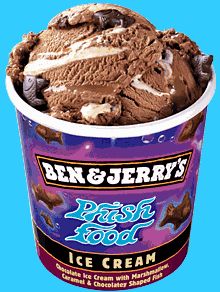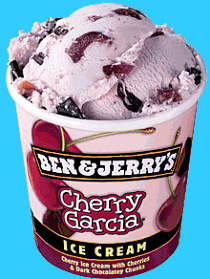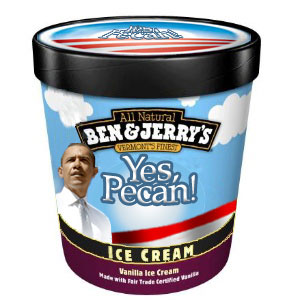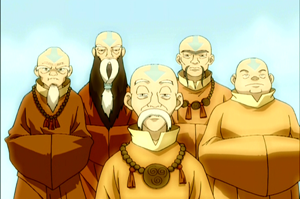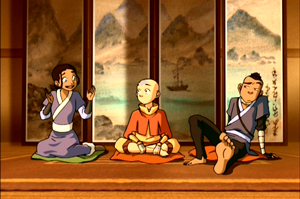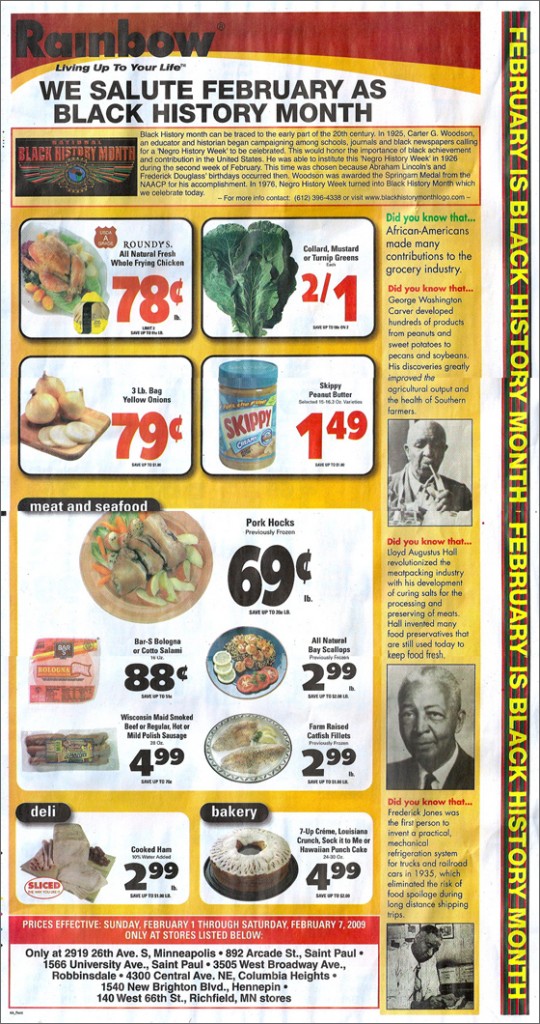
Gawker, via Copyranter.
race/ethnicity
Jay Smooth over at Ill Doctrine interviewed Elizabeth Mendez Berry (who wrote an article in Vibe several years ago about domestic violence in the hip-hop community) about the issue, which has received renewed attention in the wake of the Chris Brown/Rihanna incident:
It brings up some interesting issues–the pressure on women to not ruin the reputation of men by “airing dirty laundry” and the still-common assumption that women who are abused might have deserved it, higher rates of domestic abuse experienced by African American and Latina women than White women, etc. You might also use it to talk about the fact that both men and women hit their partners, and what that dynamic means. Overall, women in the U.S. hit more often in terms of total incidents (this includes things like the stereotypical slap across the face, not just punches), but are much less likely than men to inflict significant physical harm. Though the rates of harm caused by female aggression toward males is surely underestimated, there is little doubt that women simply do not inflict the levels of physical injury on men that men do on women each year in this country, particularly harm that requires a hospital stay or that ends in death. But I often encounter the sort of equivalency argument Jay Smooth mentions in the video–if women hit, they should be expect to be hit back, etc. It’s always a really interesting discussion, and Berry’s response might be useful for sparking some thoughts about domestic violence, personal responsibility, appropriate reactions (is hitting someone who has hit you first really the most appropriate response?), and so on.
I spent the last few days in Savannah, Georgia at the winter meeting of Sociologists for Women in Society. I’m from Maine and didn’t travel much in the U.S. as a child. It wasn’t until I was 27 that I ventured south of Washington, D.C. The history of slavery is something that I’ve always wanted to learn more about.
After spending a day at the Civil Rights Museum and touring the historic First African Baptist Church, I was stunned to find these items for sale in nearly every tourist souvenir shop.

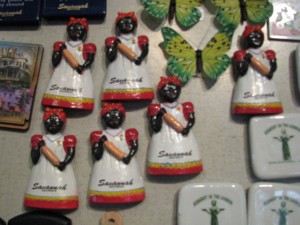

These make me uncomfortable. They’re caricatures of Black women without any kind of historical context. Like Gwen in this post, I have less of a hard time with old, historic artifacts (like the antiques pictured below that I found at a flea market). But, I do think they belong in a museum alongside other historic artifacts and information.
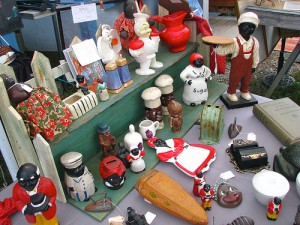
But, newly made, currently produced reproductions of Black women slaves, as salt shakers and magnets? How is that alright? To me this is almost as creepy as if they were selling Klu Klux Klan robe magnets. Is it that as a Northerner I’m more uncomfortable around issues of slavery, than, say, a Southerner would be? I feel a similiar way when I see confederate flags outside of their historical context– and there were plenty those for sale in tourist stores as well. I’d love to hear thoughts on this use of racist “history” for marketing and tourism in a city like Savannah that is filled with history of slave trade and segregation.
Stephen W. sent in a link to a music video promoting the National Guard. He saw the video before a screening of Taken in Sioux Falls, SD. At the moment, the National Guard website (warning: noisy) features Kid Rock and Dale Earnhardt Jr. The opening graphics, set to a snippet of Rock’s Warrior, feature a military helicopter followed by a race car and then a picture of an anonymous African-American National Guard member with the rock star and car star:

A few clicks into the website leads you to this music video:
[youtube]https://www.youtube.com/watch?v=QeVt4j_T7-8[/youtube]
In the photographs made available, pictures of Kid Rock’s life as a rock star are mixed with pictures of people in the National Guard, and the lines between the two blur:
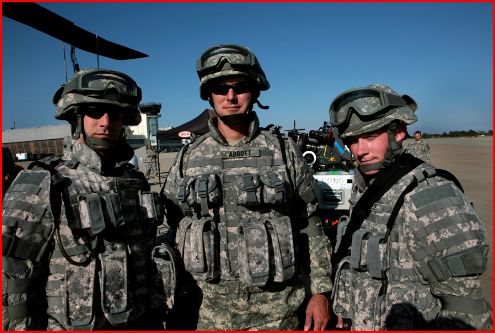


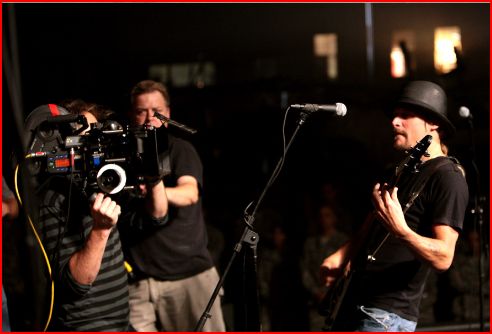
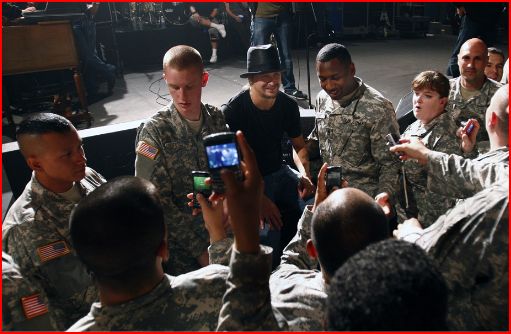
Some observations on the marketing of military service:
First, the glorification of military service is an American phenomenon. (See this post which features an American and a Swedish military recruitment commercial back-to-back. The difference is quite amazing.) In this video, the glorification is particularly acute when the light-skinned driver of the Hummer manages to avoid hitting the blue-eyed, olive-skinned, dark-haired boy and then comes out with his giant gun to kick the ball back to him, inspiring a look of awe from the child who’s country he is likely (given the politics in the last 8 years) invading. We’re left, assured, that the U.S. military are all around good folk.
Second, in this case we have military service being marketed with celebrity tie-ins. The website deliberately blurs the line between being a famous rock star, a celebrated race car driver, and a member of the National Guard. Similarly, this Air Force recruitment ad blurs the line between various extreme sports and military service:
These links between military service, skateboarding, and being a rock star are disingenuous, to say the least. And it reminds me of a series of recruitment ads I’ve been seeing lately that highlight the super cool jobs you could end up doing in the Air Force (like being a fighter pilot). I don’t know about you, but both of my family members who joined the military (in their cases, the Army) ended up being bus drivers.
Third, which celebrities are being used to market the National Guard tells us something about who they are trying to recruit. Clearly, they are reaching out to young, working class, perhaps rural, white men. This is not part of the National Guard marketing aimed specifically at this group, the entire National Guard website (warning: noisy), at this time, is entirely devoted to this theme. It speaks to who fights American wars? Studies have shown that, while once military service was required of elites, this changed during Vietnam. Today military service is overwhelmingly performed by working- and middle-class men.
Finally, the re-framing of the role from “soldier” to “warrior,” one who wages war, is very interesting. I’d love to hear your thoughts about this.
More fodder for discussion, if you need it:
Lisa Wade, PhD is an Associate Professor at Tulane University. She is the author of American Hookup, a book about college sexual culture; a textbook about gender; and a forthcoming introductory text: Terrible Magnificent Sociology. You can follow her on Twitter and Instagram.
The ownership of corporations under parent companies concentrates profits and profit motives, often in ways that undermine the progressive or conservative causes that the subsidiary companies purport to promote. Ben and Jerry’s Ice Cream is famous for its progressive and countercultural flavors and activities.
A tribute to the countercultural bands, Phish and The Grateful Dead:
A pacifist message:
The Barack Obama inspired flavor, Yes Pecan:
Alas, in 2000 Ben and Jerry’s was bought by Unilever, the company that brings us (pseudofeminist) Dove, (misogynistic) Axe, and (racist) Fair and Lovely products (examples here, here, here, here, here, here, here, and here).
Oh, to bring the irony full circle, Unilever owns Slimfast too.
Don’t shoot the messenger.
Hat tip to Jezebel.
Matt S. has pointed us to the controversy over the casting of The Last Airbender (to be released 2010). One blogger, comic book artists Derek Kirk Kim, describes the Nickelodeon cartoon series on which the life-action movie is based as follows:
[The cartoon is] wholly and inarguably built around Asian (and Inuit) culture. Everything from to the costume designs, to the written language, to the landscapes, to martial arts, to philosophy, to spirituality, to eating utensils!—it’s all an evocative, but thinly veiled, re-imagining of ancient Asia. (In one episode, a region is shown where everyone is garbed in Korean hanboks—traditional Korean clothing—the design of which wasn’t even altered at all.) It would take a willful disregard of the show’s intentions and origins to think this wouldn’t extend to the race of the characters as well.
The series–which I have never seen–does indeed seem to be inspired by various Asian cultures. Here are some images from the cartoon series (from the same blog post):
The controversy is regarding the casting of the lead characters. All four leads are white (imdb).
Jackson Rathbone (image at imdb):
Jesse McCartney (image here):
Nicola Peltz (image here):
I couldn’t find a picture of the fourth lead, Noah Ringer.
Kim quotes Gene Yang saying:
It’s like a white Asian fetishist’s wet dream. All the Asian culture they want, without any of the Asian people.
Ampersand, at Alas a Blog, puts it nicely:
…the best roles for people of color are reserved for actors who appear white — and the best roles for white people are also reserved for actors who appear white.
Mary T. sent in a photo she took of the cover of the Spanish (as in, from Spain) magazine Muy Interesante. It’s Not Safe for Work.
Sabrina W. sent in this ad for an herbal toothpaste (from Thailand?), found at Sinosplice:
[youtube]https://www.youtube.com/watch?v=5Y7eg0REXZM[/youtube]
I don’t quite know what to make of it. I mean, in theory it would be a nice message that stereotypes are often extremely misleading. But “looks can be deceiving” applying to Black people? It’s not actually undermining the idea that Black men look scary (just like herbal toothpaste might look disgusting), it’s just that it turns out that in some cases, they’re actually nice, kind people! And presumably the toothpaste tastes better than it looks.
It’s interesting that the woman is afraid the Black man is going to hurt or maybe kidnap her child. In the U.S., I don’t think that’s usually the major concern–there’s the stereotype of Blacks as muggers, and women (particularly White women) often fear that they might be sexually aggressive, but I don’t think Black men are usually depicted as child molesters or kidnappers here–the stereotype of those groups is usually of middle-aged White men.
Thanks, Sabrina!
Gwen Sharp is an associate professor of sociology at Nevada State College. You can follow her on Twitter at @gwensharpnv.
Jay Smooth over at Ill Doctrine interviewed Elizabeth Mendez Berry (who wrote an article in Vibe several years ago about domestic violence in the hip-hop community) about the issue, which has received renewed attention in the wake of the Chris Brown/Rihanna incident:
It brings up some interesting issues–the pressure on women to not ruin the reputation of men by “airing dirty laundry” and the still-common assumption that women who are abused might have deserved it, higher rates of domestic abuse experienced by African American and Latina women than White women, etc. You might also use it to talk about the fact that both men and women hit their partners, and what that dynamic means. Overall, women in the U.S. hit more often in terms of total incidents (this includes things like the stereotypical slap across the face, not just punches), but are much less likely than men to inflict significant physical harm. Though the rates of harm caused by female aggression toward males is surely underestimated, there is little doubt that women simply do not inflict the levels of physical injury on men that men do on women each year in this country, particularly harm that requires a hospital stay or that ends in death. But I often encounter the sort of equivalency argument Jay Smooth mentions in the video–if women hit, they should be expect to be hit back, etc. It’s always a really interesting discussion, and Berry’s response might be useful for sparking some thoughts about domestic violence, personal responsibility, appropriate reactions (is hitting someone who has hit you first really the most appropriate response?), and so on.
I spent the last few days in Savannah, Georgia at the winter meeting of Sociologists for Women in Society. I’m from Maine and didn’t travel much in the U.S. as a child. It wasn’t until I was 27 that I ventured south of Washington, D.C. The history of slavery is something that I’ve always wanted to learn more about.
After spending a day at the Civil Rights Museum and touring the historic First African Baptist Church, I was stunned to find these items for sale in nearly every tourist souvenir shop.



These make me uncomfortable. They’re caricatures of Black women without any kind of historical context. Like Gwen in this post, I have less of a hard time with old, historic artifacts (like the antiques pictured below that I found at a flea market). But, I do think they belong in a museum alongside other historic artifacts and information.

But, newly made, currently produced reproductions of Black women slaves, as salt shakers and magnets? How is that alright? To me this is almost as creepy as if they were selling Klu Klux Klan robe magnets. Is it that as a Northerner I’m more uncomfortable around issues of slavery, than, say, a Southerner would be? I feel a similiar way when I see confederate flags outside of their historical context– and there were plenty those for sale in tourist stores as well. I’d love to hear thoughts on this use of racist “history” for marketing and tourism in a city like Savannah that is filled with history of slave trade and segregation.
Stephen W. sent in a link to a music video promoting the National Guard. He saw the video before a screening of Taken in Sioux Falls, SD. At the moment, the National Guard website (warning: noisy) features Kid Rock and Dale Earnhardt Jr. The opening graphics, set to a snippet of Rock’s Warrior, feature a military helicopter followed by a race car and then a picture of an anonymous African-American National Guard member with the rock star and car star:

A few clicks into the website leads you to this music video:
[youtube]https://www.youtube.com/watch?v=QeVt4j_T7-8[/youtube]
In the photographs made available, pictures of Kid Rock’s life as a rock star are mixed with pictures of people in the National Guard, and the lines between the two blur:





Some observations on the marketing of military service:
First, the glorification of military service is an American phenomenon. (See this post which features an American and a Swedish military recruitment commercial back-to-back. The difference is quite amazing.) In this video, the glorification is particularly acute when the light-skinned driver of the Hummer manages to avoid hitting the blue-eyed, olive-skinned, dark-haired boy and then comes out with his giant gun to kick the ball back to him, inspiring a look of awe from the child who’s country he is likely (given the politics in the last 8 years) invading. We’re left, assured, that the U.S. military are all around good folk.
Second, in this case we have military service being marketed with celebrity tie-ins. The website deliberately blurs the line between being a famous rock star, a celebrated race car driver, and a member of the National Guard. Similarly, this Air Force recruitment ad blurs the line between various extreme sports and military service:
These links between military service, skateboarding, and being a rock star are disingenuous, to say the least. And it reminds me of a series of recruitment ads I’ve been seeing lately that highlight the super cool jobs you could end up doing in the Air Force (like being a fighter pilot). I don’t know about you, but both of my family members who joined the military (in their cases, the Army) ended up being bus drivers.
Third, which celebrities are being used to market the National Guard tells us something about who they are trying to recruit. Clearly, they are reaching out to young, working class, perhaps rural, white men. This is not part of the National Guard marketing aimed specifically at this group, the entire National Guard website (warning: noisy), at this time, is entirely devoted to this theme. It speaks to who fights American wars? Studies have shown that, while once military service was required of elites, this changed during Vietnam. Today military service is overwhelmingly performed by working- and middle-class men.
Finally, the re-framing of the role from “soldier” to “warrior,” one who wages war, is very interesting. I’d love to hear your thoughts about this.
More fodder for discussion, if you need it:
Lisa Wade, PhD is an Associate Professor at Tulane University. She is the author of American Hookup, a book about college sexual culture; a textbook about gender; and a forthcoming introductory text: Terrible Magnificent Sociology. You can follow her on Twitter and Instagram.
The ownership of corporations under parent companies concentrates profits and profit motives, often in ways that undermine the progressive or conservative causes that the subsidiary companies purport to promote. Ben and Jerry’s Ice Cream is famous for its progressive and countercultural flavors and activities.
A tribute to the countercultural bands, Phish and The Grateful Dead:
A pacifist message:
The Barack Obama inspired flavor, Yes Pecan:
Alas, in 2000 Ben and Jerry’s was bought by Unilever, the company that brings us (pseudofeminist) Dove, (misogynistic) Axe, and (racist) Fair and Lovely products (examples here, here, here, here, here, here, here, and here).
Oh, to bring the irony full circle, Unilever owns Slimfast too.
Don’t shoot the messenger.
Hat tip to Jezebel.
Matt S. has pointed us to the controversy over the casting of The Last Airbender (to be released 2010). One blogger, comic book artists Derek Kirk Kim, describes the Nickelodeon cartoon series on which the life-action movie is based as follows:
[The cartoon is] wholly and inarguably built around Asian (and Inuit) culture. Everything from to the costume designs, to the written language, to the landscapes, to martial arts, to philosophy, to spirituality, to eating utensils!—it’s all an evocative, but thinly veiled, re-imagining of ancient Asia. (In one episode, a region is shown where everyone is garbed in Korean hanboks—traditional Korean clothing—the design of which wasn’t even altered at all.) It would take a willful disregard of the show’s intentions and origins to think this wouldn’t extend to the race of the characters as well.
The series–which I have never seen–does indeed seem to be inspired by various Asian cultures. Here are some images from the cartoon series (from the same blog post):
The controversy is regarding the casting of the lead characters. All four leads are white (imdb).
Jackson Rathbone (image at imdb):
Jesse McCartney (image here):
Nicola Peltz (image here):
I couldn’t find a picture of the fourth lead, Noah Ringer.
Kim quotes Gene Yang saying:
It’s like a white Asian fetishist’s wet dream. All the Asian culture they want, without any of the Asian people.
Ampersand, at Alas a Blog, puts it nicely:
…the best roles for people of color are reserved for actors who appear white — and the best roles for white people are also reserved for actors who appear white.
Mary T. sent in a photo she took of the cover of the Spanish (as in, from Spain) magazine Muy Interesante. It’s Not Safe for Work.
Sabrina W. sent in this ad for an herbal toothpaste (from Thailand?), found at Sinosplice:
[youtube]https://www.youtube.com/watch?v=5Y7eg0REXZM[/youtube]
I don’t quite know what to make of it. I mean, in theory it would be a nice message that stereotypes are often extremely misleading. But “looks can be deceiving” applying to Black people? It’s not actually undermining the idea that Black men look scary (just like herbal toothpaste might look disgusting), it’s just that it turns out that in some cases, they’re actually nice, kind people! And presumably the toothpaste tastes better than it looks.
It’s interesting that the woman is afraid the Black man is going to hurt or maybe kidnap her child. In the U.S., I don’t think that’s usually the major concern–there’s the stereotype of Blacks as muggers, and women (particularly White women) often fear that they might be sexually aggressive, but I don’t think Black men are usually depicted as child molesters or kidnappers here–the stereotype of those groups is usually of middle-aged White men.
Thanks, Sabrina!
Gwen Sharp is an associate professor of sociology at Nevada State College. You can follow her on Twitter at @gwensharpnv.

